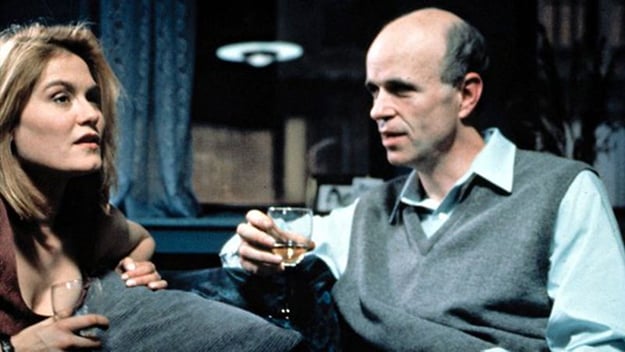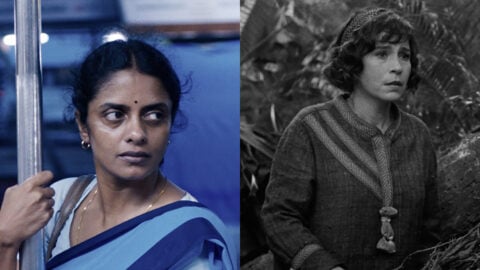Present Tense: What Happened Was...
Present Tense is a column by Sheila O’Malley that reflects on the intersections of film, literature, art, and culture.

What Happened Was… (Tom Noonan, 1994)
Loneliness is difficult to discuss because the experience defies language itself. Acute loneliness is such a terrible thing that people will do anything—anything—to avoid it. Songs are better equipped to express loneliness than speech or the written word. Certain chord changes evoke it (The Beach Boys were masters at this), and lyrics can cut to the heart of the matter. Hank Williams knew loneliness from the inside out: “The silence of a falling star lights up a purple sky / And as I wonder where you are / I’m so lonesome I could cry.” In “Eleanor Rigby” (basically Bergman’s Winter Light in song form) The Beatles worry about “all the lonely people,” and the lyrics portray isolation so total as to be absolute (“Nobody came”).
In her 2016 book The Lonely City: Adventures in the Art of Being Alone, an essential entry in the sparse study of loneliness, Olivia Laing writes, “What does it feel like to be lonely? It feels like being hungry: like being hungry when everyone around you is readying for a feast. It feels shameful and alarming, and over time these feelings radiate outwards, making the lonely person increasingly isolated, increasingly estranged.” When I read Laing’s book, I thought of 1994’s What Happened Was…, written and directed by Tom Noonan, one of the great films about loneliness, in particular loneliness of the urban variety. The film unnerved me so much when I saw it in its initial release—25 years ago—that it was a long time before I re-visited it. Images from it haunted me for years. Marketed as a meet-cute gone awry, What Happened Was… is, instead, an unblinking look at the havoc loneliness can wreak on humans. It’s only 91 minutes, but every minute is excruciating.
Jackie (Karen Sillas) and Michael (Noonan) work at a New York law firm, she as an executive assistant (don’t call her a “secretary”) and Michael as a paralegal. Jackie has invited him over for dinner, and she races around beforehand, getting ready, blasting Til Tuesday’s “Voices Carry,” gulping down a glass of wine. (Sillas is brilliant at tracking Jackie’s intoxication over the course of the night.) When Michael arrives, his manner is so off-putting it’s not clear what she sees in him. He talks with self-importance about a book he’s writing, an exposé of the corrupt firm where they work. He talks about his agent, the “publishers” who’ve been “handling” him. She’s from Long Island and went to a technical school, so the status difference is obvious: he is “above” her (when he tells her he went to Harvard, she says, “You mean the Harvard?”) and he sees her as “below” him. But then the event shifts, and she rises in status, exploding any preconceived notions he—or we—might have had about her.
Jackie is not “still waters” (in fact, she rarely lets him get a word in edgewise), but she runs deep. The drunker she gets, the more unpredictable she becomes, and—in reaction—the quicker he deteriorates. Finally comes the unforgettable centerpiece scene, where Jackie reveals that she, too, is a writer, and not only that, but—unlike Michael—her book has actually been published. As she reads him the first chapter of her extremely disturbing children’s book, he dissociates from reality, and then can’t quite find the way back to who he was five minutes before. And she? Her disappointment is so extreme you get the sense her “final straw” snapped a long, long time ago. By the end, they both look like they’ve been skinned alive. Dreams have died. For good. Even with its humorous moments (and there are many) this is not ingratiating material.
Unfolding almost in real time, What Happened Was... started as a play. Similar to his friend John Cassavetes (Noonan appears uncredited in Gloria), Noonan made a career of playing “heavies” in big movies like Manhunter and RoboCop 2, pouring his salary into developing his own work. A veteran of the New York theater scene, a contemporary of Lanford Wilson (who wrote a play for him) and Sam Shepard (Noonan was in the original New York production of Buried Child in 1978), Noonan created the Paradise Factory Theatre in 1983, and it has perched on East 4th Street ever since. While shooting RoboCop 2, Noonan decided to take some time off to do a play. He wrote What Happened Was… very quickly: from first draft to production was just a year. The play, starring Noonan and Sillas, opened at the Paradise in 1992. Done in the round, the audience sat onstage, proscenium arch obliterated. Noonan replicated this in-the-round feeling when he filmed it the following year.
What Happened Was... won the Grand Jury Prize at Sundance, and Noonan’s screenplay also won. It was nominated for a couple of Independent Spirit Awards. The official trailer completely misrepresents the film, making it look like an erotic thriller. When it was released, most critics didn’t care for it. They “didn’t feel chemistry between the characters”, or they found it “not as profound as the festival laurels imply.” It was “tiresome,” Jackie and Michael were a “pathetic pair.” A few critics engaged seriously with What Happened Was... understanding that “quirky rom-com” or “black comedy” were, in fact, category errors, and the film needed to be measured for what it was, not what it wasn’t. What Happened Was... takes place in Edward Hopper’s New York, where city dwellers hole up in private spaces flickering with trauma, surrounded by masses of people, but isolated by walls and glass. It’s not about two lonely souls finding one another, or even two lonely souls sharing a moment of connection. What Happened Was... is more Winter Light than Before Sunrise. It’s better to know this upfront, because there is an audience for films like What Happened Was...
Criminally, What Happened Was... has never been released on DVD or Blu-ray. You can find it on streaming platforms (albeit with poor image quality). The film deserves a renaissance. It features two performances that make others look shallow, facile, or self-important. Both actors go to places many actors not only won’t, but can’t, go. Something about the way Noonan plays Michael clues us in that the character’s default stance of jaundiced superiority is protective coloration, not an accurate representation of who he is. And Sillas works in a very dangerous zone, the thin-oxygen territory of Bibi Andersson, Gena Rowlands, Theresa Russell. She deserves to be spoken in the same breath. Along with everything else, What Happened Was... is a thrilling two-hander.
Jackie and Michael come into the date with compromised emotional immune systems. Whatever resilience they may have had once is long gone. “That which does not kill you makes you stronger” is a lie, or at least a “fiction” parroted by people who have been privileged enough not to know real suffering. There’s something pathological and, dare I say, capitalistic, about the phrase. Being “strong” isn’t the only positive value in life. “That which does not kill you” can kill other things, too, things like vulnerability, humor, the capacity to connect with others—in short, the things that make life worth living. When writing about her own loneliness, Olivia Laing remembers how “perception around social interactions had begun to warp. Somewhere in my body, a measuring system had identified danger, and now the slightest glitch in communication was registering as a potentially overwhelming threat.” Both Jackie and Michael live in this state of hypervigilance, making not just connection—but conversation—almost impossible.
Part of the fascination of What Happened Was... is the surreal atmosphere of Jackie’s apartment. The walls are painted dark blue, but the kitchen glows pink. The curtains at the windows—stretching along on two sides of the apartment—seem to shift in color over time, changing from blue to a soft pink. It’s an intriguingly gender-separated color scheme. The windows stare out at other buildings, where people are seen doing strange things (there’s what seems to be an acting class in progress, a man watches movies, another man paces in an office). Sometimes the sound distorts, as though Jackie—or Michael—can hear what’s going on over there. Crucial contributions come from Daniel Ouellette’s production design and Andras Kanegson’s set decoration. A mannequin stands in the corner draped in scarves. There’s a china cat which seems to have some significance to Jackie (she clutches it in her hand in the opening shot). There are two posters on the wall, one of Martin Luther King Jr., and one of the Broadway show of Cats. The space is revealing but also totally withholding. It’s impossible to “get a line” on Jackie from her decor. Hidden behind curtains on one wall is a private area, glowing red like a womb. This nursery-like space is where the childless Jackie enters her dark creative life and writes her terrible tales. Old dolls pile up against the wall, a child’s goose-shaped lamp sits on the floor alongside a dollhouse and a steamer trunk filled with her composition notebooks. Joe DeSalvo shot the film, using some jittery effects, subtle but effective, zooming in on Jackie when Michael rings the buzzer, sometimes using dramatic focus-shifts into the apartments across the way. It’s Edward Hopper or Rear Window on hallucinogens.
“The Loneliness One dare not sound,” Emily Dickinson wrote, making an insightful observation on the taboo topic of loneliness. People recoil from hearing about it. As Douglas Coupland joked, “Forget sex or politics or religion. Loneliness is the subject that clears out a room.” The prevailing attitude is: if only the people whining about how lonely they are would just “put themselves out there” more, or stop feeling sorry for themselves, maybe then they’d find a mate, have a happier life. In The Lonely City, Laing profiles different artists who evoke loneliness in their work, the first being the most obvious, Edward Hopper. Laing observes that Hopper’s paintings are filled with “women who appear to be in the grips of a loneliness that has to do with gender and unattainable standards of appearance, and that gets increasingly toxic and strangulating with age.” Jackie knows this, she lives it. As I prepared to write this essay, I dug into Hopper’s work myself. When I look at his famous Nighthawks with fresh eyes, a couple different things stand out, things which call to mind What Happened Was… Who are “all the lonely people” in Nighthawks: is it the four insomniacs in the diner or is it Hopper the painter, or is it the viewer—i.e., us—wishing we could enter that oasis of light, even if it’s just to join the company of strangers? But then comes the alarming realization that the diner has no door, or at least not one that’s visible in the frame. There’s no way in, for us, and there’s no way out, for them.
A better metaphor for loneliness doesn’t exist, although Jackie’s apartment in What Happened Was... comes close. There, surrounded by dark blue walls and huge windows, loneliness is not situational, circumstantial, or seasonal. It’s a permanent condition. There will always be those who don’t want to look at this. But to those of us who recognize and value its truths, the film is a bracing tonic, clear and sharp and icy cold.
Sheila O’Malley is a regular film critic for Rogerebert.com and other outlets including The Criterion Collection. Her blog is The Sheila Variations.







